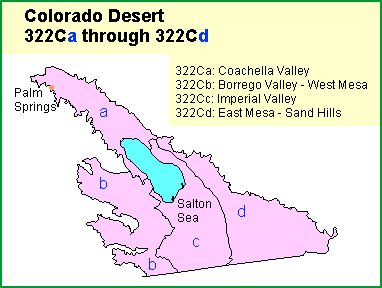--
Section 322C
Colorado Desert
This section is a very hot part of the Basin and Range Province that is sometimes called the Salton Trough. The surface of sediments in the middle of the trough are about 275 feet below sea-level. The delta of the Colorado River is generally high enough to keep sea water out of the Salton Trough. In 1905, however, the Colorado River overflowed into the Salton Trough and the breach was not finally sealed until 1907. The current level of the Salton Sea is about 230 feet below sea level. An ancient lake, Lake Cahuilla, was higher long enough to produce shore-line features that reveal its greater size. The subsection is in MLRAs 30 and 31.
Geomorphology. Alluvial fans, basin, dunes and delta plain (Gulf of California). Basin and Range geomorphic province (Colorado Desert).
Lithology. Cenozoic sedimentary rocks and alluvial, lacustrine, and eolian deposits.
Soil Taxa. Aridisols and Entisols with hyperthermic soil temperature regimes and aridic soil moisture regimes.
Vegetation. Predominant potential natural communities includes the Creosote bush - white bursage series, Allscale series, Mixed salt bush series, Mesquite series, Ocotillo series and Fan palm series.
The following series are found throughout the section and are not restricted to or extensive in any subsection. Series dominated by exotic plants are not listed under subsections unless they are extensive and stable.
Series dominated by exotic plants: California annual grassland series, Gaint reed series and Tamarisk series.Fauna. Mammals include desert bighorn sheep, desert kit fox, coyote, spotted skunk, spotted bat, black-tailed jackrabbit, ground squirrels, kangaroo rat and white footed mouse. Birds includes eagles, hawks, owls, quail, white-winged dove, roadrunners, finches, warblers and orioles. The Salton Sea provides habitat for a wide variety of waterfowl and shorebirds. Reptiles include several species of rattlesnakes.
Series that can occur in all subsections, but are not extensive: Bulrush series, Bulrush - cattail series, Cattail series, Duckweed series, Mosquito fern series, One-sided bluegrass series, Pondweeds with floating leaves series, Pondweeds with submerged leaves series, Saltgrass series, Sedge series and Spikerush series.
Series restricted to riparian settings: Black willow series, Fremont cottonwood series, Mixed willow series, Mulefat series, Narrowleaf willow series and Red willow series.
Elevation. 230 feet below sea level to 2200 feet.
Precipitation. 3 to 6 inches.
Temperature. 68° to 75°F.
Growing Season. 300 to 350 days.
Surface Water Characteristics. Mostly bedrock controlled channels in mountains that carry seasonal flows through alluvial channels below to the Salton Sea. A few rivers that evolved from irrigation drainage water flow to the Salton Sea from Imperial and Coachella Valleys. The largest surface water feature is the Salton Sea (about 40 by 16 miles).
Disturbance Regimes.
Climate: Strong winds and drifting sand are common in parts of the area. Flash floods are commonly associated with the irregular occurrence of precipitation events. Precipitation does not occur every year.Land Use. Composition and successional sequence of some communities has changed because of plant and animal species introduced between the early 1800’s and early 1900’s related to grazing, agriculture, and urbanization. Most of the section is converted to irrigated agriculture. Increased salinization of soil and water occurs in some areas as a result of modified drainage. Rapidly expanding urbanized areas are scattered throughout the section.
Cultural Ecology. Humans have been utilizing the area for some 10,000 years. After the end of the Pleistocene hunting traditions, Archaic assemblages reflect extensive practice of seasonal rounds for diversified hunting and gathering. Agricultural practices of Colorado River cultures spread throughout the area during late prehistoric times, after A.D. 1000; and, in just recent historic times, large areas have been converted to irrigated agriculture. The recently formed Salton Sea has become a mecca for retirement, recreation, and development. Contemporary attitudes and beliefs are varied; lifestyle is rural. The international border and large Hispanic populations contribute to cultural diversity; Hispanic populations comprise much of the agricultural, often migrant, workforce. The economy emphasizes agriculture, government employment, and recreation.
Subsections. The Colorado Desert section is divided into
4 subsections.
Clickable map
